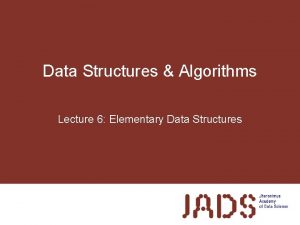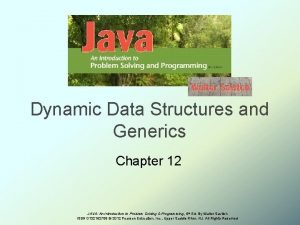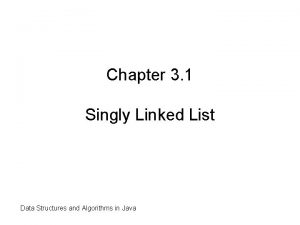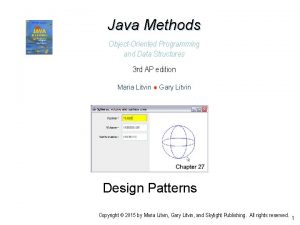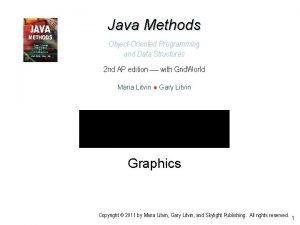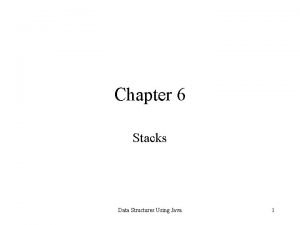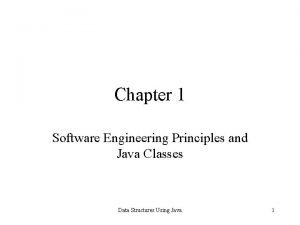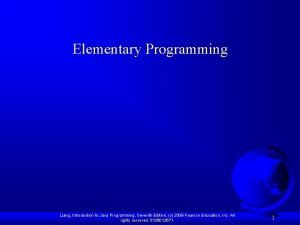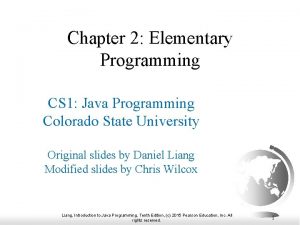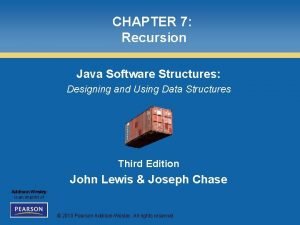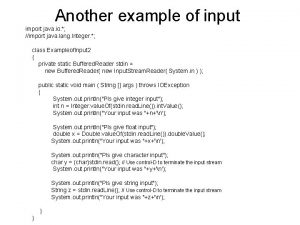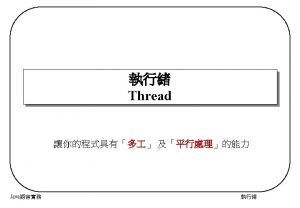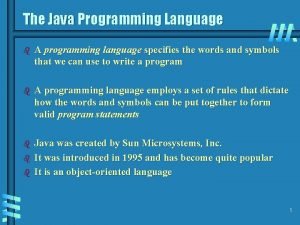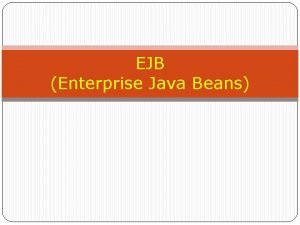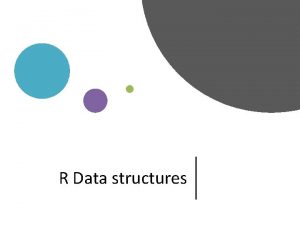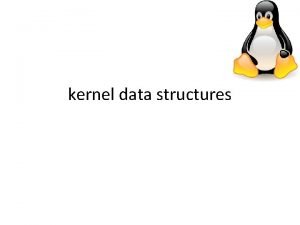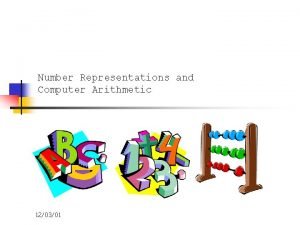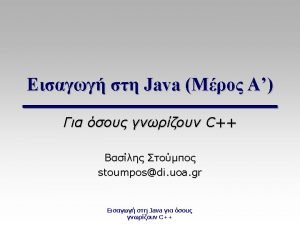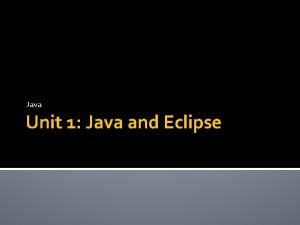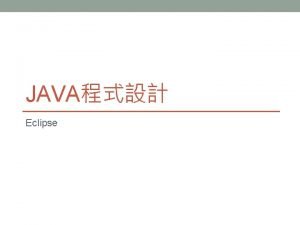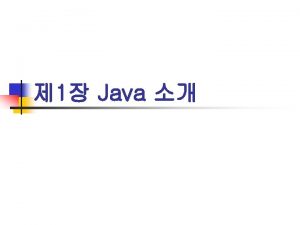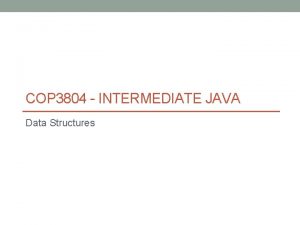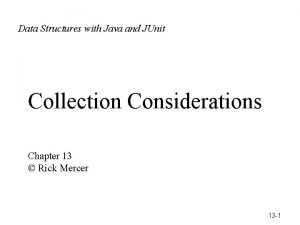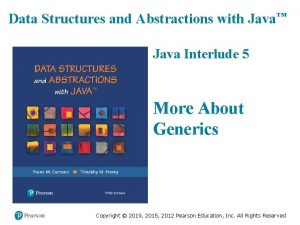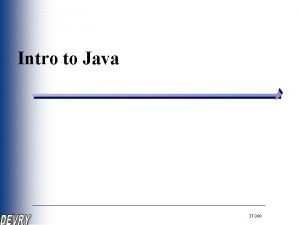Data Structures in Java 120301 Elementary Data Structures



![Array Implementation for a Stack of ints public class Array. Stack { int store[]; Array Implementation for a Stack of ints public class Array. Stack { int store[];](https://slidetodoc.com/presentation_image/494f7b465c52e30e050e300859dfd3b6/image-4.jpg)




















![Array. Queue public class Array. Queue implements Queue { Object store[]; int front, rear; Array. Queue public class Array. Queue implements Queue { Object store[]; int front, rear;](https://slidetodoc.com/presentation_image/494f7b465c52e30e050e300859dfd3b6/image-25.jpg)














- Slides: 39

Data Structures in Java 12/03/01

Elementary Data Structures n Stack n n Queue n n container of elements that are inserted and removed first-in first-out (FIFO) Linked List n n n 2/26/02 container of elements that are inserted and removed last-in first-out (LIFO) chain of elements can grow dynamically often used to implement other data structures © 2002 Luis F. G. Sarmenta and John Paul Vergara, Ateneo de Manila University Slide 12/03/01

Stack n n Last-in, First-out (LIFO) structure Operations n n push: add element into the stack pop: remove & return topmost element empty: check if the stack has no elements Sample uses n 2/26/02 “Back” button of a browser, “Undo” operation, function/method calls © 2002 Luis F. G. Sarmenta and John Paul Vergara, Ateneo de Manila University Slide 12/03/01
![Array Implementation for a Stack of ints public class Array Stack int store Array Implementation for a Stack of ints public class Array. Stack { int store[];](https://slidetodoc.com/presentation_image/494f7b465c52e30e050e300859dfd3b6/image-4.jpg)
Array Implementation for a Stack of ints public class Array. Stack { int store[]; int top; static final int MAX = 100; public Array. Stack() { store = new int[MAX]; top = 0; } //. . . } 12 24 2/26/02 37 17 top 4 top = index of the first FREE slot . . . © 2002 Luis F. G. Sarmenta and John Paul Vergara, Ateneo de Manila University Slide 12/03/01

Array. Stack class, continued public class Array. Stack { //. . . public boolean empty() { return (top == 0); } public void push(int entry) { if (top < MAX) store[top++] = entry; } //. . . } 12 24 2/26/02 37 17 // in the code that uses // the stack … stack. push( 95 ); Remember: top = index of the first FREE slot top 45 95 . . . © 2002 Luis F. G. Sarmenta and John Paul Vergara, Ateneo de Manila University Slide 12/03/01

Array. Stack class, continued public class Array. Stack { //. . . public int pop() throws Exception { if ( empty() ) throw new Exception(); else return store[--top]; } } 12 24 2/26/02 37 17 // in the code that uses // the stack … int x = stack. pop(); // x gets 95, // slot 4 is now free Remember: top = index of the first FREE slot top 54 95 Store[4] still contains 95, but it’s now considered “free”. . © 2002 Luis F. G. Sarmenta and John Paul Vergara, Ateneo de Manila University Slide 12/03/01

Using the Stack try { Array. Stack st = new Array. Stack(); st. push( 1 ); st. push( 3 ); st. push( 2 ); System. out. println( st. pop() ); st. push( 5 ); System. out. println( st. pop() ); } catch ( Exception e ) { System. out. println( “pop() on empty stack” ); } 2/26/02 © 2002 Luis F. G. Sarmenta and John Paul Vergara, Ateneo de Manila University Slide 12/03/01

Problems with Array Implementation n n MAX needs to be specified Consequences n n n stack may fill up (when top == MAX) memory is wasted if actual stack consumption is way below maximum Need a more “dynamic” implementation 2/26/02 © 2002 Luis F. G. Sarmenta and John Paul Vergara, Ateneo de Manila University Slide 12/03/01

Linked List Implementation n Stack as a sequence of nodes top 5 2/26/02 1 3 © 2002 Luis F. G. Sarmenta and John Paul Vergara, Ateneo de Manila University 2 null Slide 12/03/01

Integer Node public class Int. Node { int data; Int. Node next; // set public & get methods for data and next void set. Data( int data ). . . int get. Data(). . . void set. Next( Int. Node next ). . . Int. Node get. Next(). . . } 2/26/02 © 2002 Luis F. G. Sarmenta and John Paul Vergara, Ateneo de Manila University Slide 12/03/01

Linked List as a Data Structure n Operations on a linked list n n n insert a node somewhere in the list get next node delete a node from the list The Int. Node class supports the Linked List structure Linked List Implementation of a Stack: n 2/26/02 an example of a data structure implemented through another data structure © 2002 Luis F. G. Sarmenta and John Paul Vergara, Ateneo de Manila University Slide 12/03/01

Linked. Stack Class public class Linked. Stack { Int. Node top; public Linked. Stack() { top = null; } public boolean empty() { return (top == null); } //. . . } top 5 2/26/02 1 3 2 © 2002 Luis F. G. Sarmenta and John Paul Vergara, Ateneo de Manila University null Slide 12/03/01

Push Operation using a List // in the code // that uses the // stack. push( 7 ); temp top public class Linked. Stack { //. . . public void push( int entry ) { Int. Node temp = new Int. Node(); temp. set. Data( entry ); temp. set. Next( top ); top = temp; } //. . . } X 7 2/26/02 5 1 3 © 2002 Luis F. G. Sarmenta and John Paul Vergara, Ateneo de Manila University 2 null Slide 12/03/01

Pop Operation using a List // in the code // that uses the // stack int x = stack. pop(); temp top 7 Garbage Collected 7 2/26/02 X 5 public class Linked. Stack { //. . . public int pop() throws Exception { if ( empty() ) { throw new Exception(); } else { int temp = top. get. Data(); top = top. get. Next(); return temp; } } } 1 3 © 2002 Luis F. G. Sarmenta and John Paul Vergara, Ateneo de Manila University 2 null Slide 12/03/01

Separating Interface from Implementation n Better if there is a Stack interface that both Array. Stack and Linked. Stack implements public interface Stack { public void push( int entry ); public int pop() throws Exception; public boolean empty(); } 2/26/02 © 2002 Luis F. G. Sarmenta and John Paul Vergara, Ateneo de Manila University Slide 12/03/01

Stack Implementations public class Array. Stack implements Stack {. . . } public class Linked. Stack implements Stack {. . . } 2/26/02 © 2002 Luis F. G. Sarmenta and John Paul Vergara, Ateneo de Manila University Slide 12/03/01

A Stack. Factory Class n Use a separate class that produces Stack objects public class Stack. Factory { public static Stack create. Stack() { return new Array. Stack(); // or return new Linked. Stack(); } } n Advantage: n n 2/26/02 if you want to change your implementation, you just need to change Stack. Factory you don’t need to change all calls to new Array. Stack in all your code! © 2002 Luis F. G. Sarmenta and John Paul Vergara, Ateneo de Manila University Slide 12/03/01

Sample Code (application that uses a stack) Stack st; st = Stack. Factory. create. Stack(); // above statement does not know or care // how the stack is implemented st. push(1); st. push(3); st. push(2); System. out. println( st. pop() ); //. . . 2/26/02 © 2002 Luis F. G. Sarmenta and John Paul Vergara, Ateneo de Manila University Slide 12/03/01

A Generic Stack n Make the stack data an instance of Object n n n Array implementation: n n can work with any kind of object, not just int you can use Integer class for int data (same for other primitive types) store is an Object[], instead of int[] Linked List implementation: n n 2/26/02 use Object. Node (not just Int. Node) more code later © 2002 Luis F. G. Sarmenta and John Paul Vergara, Ateneo de Manila University Slide 12/03/01

Linked Stack of Objects top null 2/26/02 © 2002 Luis F. G. Sarmenta and John Paul Vergara, Ateneo de Manila University Slide 12/03/01

Java’s Stack Class n n Good news: the java. util package already has a Stack (of objects) class Methods available n n 2/26/02 javap java. util. Stack others besides push, pop, and empty © 2002 Luis F. G. Sarmenta and John Paul Vergara, Ateneo de Manila University Slide 12/03/01

Queue n n First-in, First-out (FIFO) structure Operations n n enqueue: insert element at rear dequeue: remove & return front element empty: check if the queue has no elements Sample use n 2/26/02 handling requests and reservations © 2002 Luis F. G. Sarmenta and John Paul Vergara, Ateneo de Manila University Slide 12/03/01

The Queue Interface public interface Queue { public void enqueue( Object entry ); public Object dequeue() throws Exception; public boolean empty(); } 2/26/02 © 2002 Luis F. G. Sarmenta and John Paul Vergara, Ateneo de Manila University Slide 12/03/01

Array Implementation of Queues n An Object array and two integers n n front: index of first element in queue rear: index of first FREE element in queue front 0 rear 4. . . 2/26/02 © 2002 Luis F. G. Sarmenta and John Paul Vergara, Ateneo de Manila University Slide 12/03/01
![Array Queue public class Array Queue implements Queue Object store int front rear Array. Queue public class Array. Queue implements Queue { Object store[]; int front, rear;](https://slidetodoc.com/presentation_image/494f7b465c52e30e050e300859dfd3b6/image-25.jpg)
Array. Queue public class Array. Queue implements Queue { Object store[]; int front, rear; static final int MAX = 100; public Array. Queue() { store = new Object[MAX]; front = rear = 0; } //. . . } 2/26/02 © 2002 Luis F. G. Sarmenta and John Paul Vergara, Ateneo de Manila University Slide 12/03/01

Check for Empty and Enqueue public class Array. Queue implements Queue { //. . . public boolean empty() { // queue is empty if first element // is the same as the first free element return ( front == rear ); } public void enqueue( Object o ) { // put data in first free slot // move rear index to next slot if ( rear < MAX ) store[rear++] = o; } //. . . rear front } 4 0 . . . 2/26/02 © 2002 Luis F. G. Sarmenta and John Paul Vergara, Ateneo de Manila University Slide 12/03/01

Dequeue Operation public class Array. Queue implements Queue { //. . . public Object dequeue() throws Exception { if ( empty() ) { throw new Exception(); } else { return store[front++]; } rear } front } 4 0 . . . 2/26/02 © 2002 Luis F. G. Sarmenta and John Paul Vergara, Ateneo de Manila University Slide 12/03/01

Dequeue that allows GC public class Array. Queue implements Queue { // … public Object dequeue() throws Exception { if ( empty() ) { throw new Exception(); } else { Object data = store[front]; // get front data // set pointer to null, so it can be garbage-collected // later (when caller code doesn’t let’s go of pointer store[front] = null; front++; return data; } } rear front } 0 4 . . . 2/26/02 © 2002 Luis F. G. Sarmenta and John Paul Vergara, Ateneo de Manila University Slide 12/03/01

Circular Array n n n Suppose many enqueue operations followed by many dequeue operations Result: rear approaches MAX but the queue is not really full Solution: Circular Array n 2/26/02 allow rear (and front) to “wrap around” the array (if rear = MAX-1, incrementing rear means resetting it to 0) © 2002 Luis F. G. Sarmenta and John Paul Vergara, Ateneo de Manila University Slide 12/03/01

Circular Array, continued n When is the array full? n n n Solution: Reserve a slot n n n Simple answer: when (rear == front) Problem: this is the same condition as empty full: empty: when ( (rear+1) % MAX == front) (one free slot left) when ( rear == front ) Note: “wastes” a slot n n n alternative: have a boolean field called has. Elements full: when ( has. Elements && (rear == front)) But not really better n n 2/26/02 has. Elements takes up extra space too Also, need to take care of has. Elements in enqueue and dequeue © 2002 Luis F. G. Sarmenta and John Paul Vergara, Ateneo de Manila University Slide 12/03/01

Revised Enqueue public class Array. Queue implements Queue { //. . . public void enqueue( Object o ) { if ( (rear + 1) % MAX != front ) { store[rear] = o; rear = (rear + 1) % MAX; } } //. . . } 2/26/02 © 2002 Luis F. G. Sarmenta and John Paul Vergara, Ateneo de Manila University Slide 12/03/01

Revised Dequeue public class Array. Queue implements Queue { //. . . public Object dequeue() throws Exception { if ( empty() ) { throw new Exception(); } else { Object data = store[front]; store[front] = null; front = (front + 1) % MAX; return data; } } © 2002 Luis F. G. Sarmenta and John Paul Vergara, } 2/26/02 Ateneo de Manila University Slide 12/03/01

Using the Queue q = new Array. Queue(); int result; // the following should be enclosed in a try-catch stmt q. enqueue( new Integer(5) ); q. enqueue( new Integer(2) ); result = ((Integer)q. dequeue()). int. Value(); System. out. println(result); q. enqueue( new Integer(3) ); result = ((Integer)q. dequeue()). int. Value(); System. out. println( result ); 2/26/02 © 2002 Luis F. G. Sarmenta and John Paul Vergara, Ateneo de Manila University Slide 12/03/01

Linked List Implementation front rear null 2/26/02 © 2002 Luis F. G. Sarmenta and John Paul Vergara, Ateneo de Manila University Slide 12/03/01

The Object. Node Class public class Object. Node { Object data; Object. Node next; public void set. Data( Object o ) { data = o; } Object get. Data() { return data; } void set. Next( Object. Node p ) { next = p; } Object. Node get. Next() { return next; } } 2/26/02 © 2002 Luis F. G. Sarmenta and John Paul Vergara, Ateneo de Manila University Slide 12/03/01

Enqueue front rear null 2/26/02 © 2002 Luis F. G. Sarmenta and John Paul Vergara, Ateneo de Manila University Slide 12/03/01

Dequeue front rear null return this object 2/26/02 © 2002 Luis F. G. Sarmenta and John Paul Vergara, Ateneo de Manila University Slide 12/03/01

The Linked. Queue Class public class Linked. Queue implements Queue { Object. Node front; Object. Node rear; public Linked. Queue() { front = rear = null; } // other Queue methods } 2/26/02 © 2002 Luis F. G. Sarmenta and John Paul Vergara, Ateneo de Manila University Slide 12/03/01

Exercise: Snake game n Run the game n n n Note that it uses an instance of the Queue interface currently, it uses Array. Queue, as defined in lecture Complete the Linked. Queue class n need to worry about n n n the “empty-queue” case and the case where the queue has only 1 element Modify Queue. Factory class to create a Linked. Queue instead of Array. Queue Test your Linked. Queue by running Snake Enhance/Fix Snake n 2/26/02 e. g. , add a border, add special points, etc. © 2002 Luis F. G. Sarmenta and John Paul Vergara, Ateneo de Manila University Slide 12/03/01
 Elementary data structures
Elementary data structures Elementary data structures
Elementary data structures Advanced data structures in java
Advanced data structures in java Java dynamic data structures
Java dynamic data structures Data structures and abstractions with java
Data structures and abstractions with java Singly linked list in data structure
Singly linked list in data structure Data structures in java
Data structures in java Data structures in java
Data structures in java Data structures using java
Data structures using java Binary search tree java
Binary search tree java Data structures using java
Data structures using java Programming c
Programming c Elementary programming in java
Elementary programming in java Elementary programming in java
Elementary programming in java What is elementary data organization in data structure
What is elementary data organization in data structure Biology homology
Biology homology Java software structures 4th edition
Java software structures 4th edition Java number
Java number Import java.util.*
Import java.util.* Import java.awt.*
Import java.awt.* How to import java.util.scanner
How to import java.util.scanner Import java
Import java Import java.util.scanner;
Import java.util.scanner; Import java.util
Import java.util Import java.io.* in java
Import java.io.* in java Import.java.util.*
Import.java.util.* Java import java.io.*
Java import java.io.* Perbedaan awt dan swing
Perbedaan awt dan swing Import java.awt.event
Import java.awt.event Java interpreter
Java interpreter Javatpoint ejb
Javatpoint ejb Utopian simplex protocol
Utopian simplex protocol High school data walls
High school data walls Elementary data link protocols in computer networks
Elementary data link protocols in computer networks Sliding window protocol data link layer
Sliding window protocol data link layer Btechsmartclass data structures
Btechsmartclass data structures R data structures
R data structures Oblivious data structures
Oblivious data structures Linux kernel map data structure
Linux kernel map data structure Introduction to data structures
Introduction to data structures

